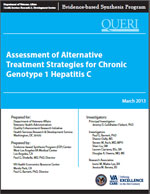
|
Principal Investigator:
Jeremy D. Goldhaber-Fiebert, PhD Evidence-based Synthesis Program (ESP) Center West Los Angeles VA Medical Center Washington (DC): Department of Veterans Affairs; March 2013 |
Download PDF: Complete Report, Executive Summary, Report, Appendices
There is great potential to improve health outcomes for Veterans and other patients with chronic genotype 1 (GT1) Hepatitis C (HCV) infections through the use of newly-available directly acting antiviral (DAA) medications and patient genotyping (IL-28B). Chronic GT1 HCV infections have been historically difficult to treat with low cure rates on standard two drug therapy (Pegylated Interferon + Ribavirin), high rates of side-effects and treatment discontinuation, and low rates of uptake. Recently, FDA approved two DAAs (boceprevir and telaprevir). Used in combination with standard two drug therapy as triple therapy, these DAAs show higher rates of sustained viral response, though they are also more costly and have more severe side-effect profiles. IL-28B genotyping can help to identify patients least likely to respond to standard therapy and hence who stand to benefit the most from triple therapy and for whom, therefore, the increased risks of side-effects may be most justified.
To achieve the potential health benefits from DAAs and IL-28B genotyping while acknowledging very real budgetary and resource constraints, proactive planning supported by appropriate analyses is needed. VA added boceprevir to its formulary approximately a year ago, allows the use of telaprevir off formulary for a number of reasons, and has the capability to use IL-28B patient genotyping as well. Responding to a request for guidance submitted to the VA Evidence-based Synthesis Program (ESP), we undertook a set of preliminary studies aimed at providing rapid, timely estimates of cost, resource and health impacts of using DAAs and/or IL- 28B genotyping within VA over a 5 year time horizon.
Specifically, we addressed four related questions:
Assessment of Alternative Treatment Strategies for Chronic Genotype 1 Hepatitis C: A Systematic Review (Management eBrief)